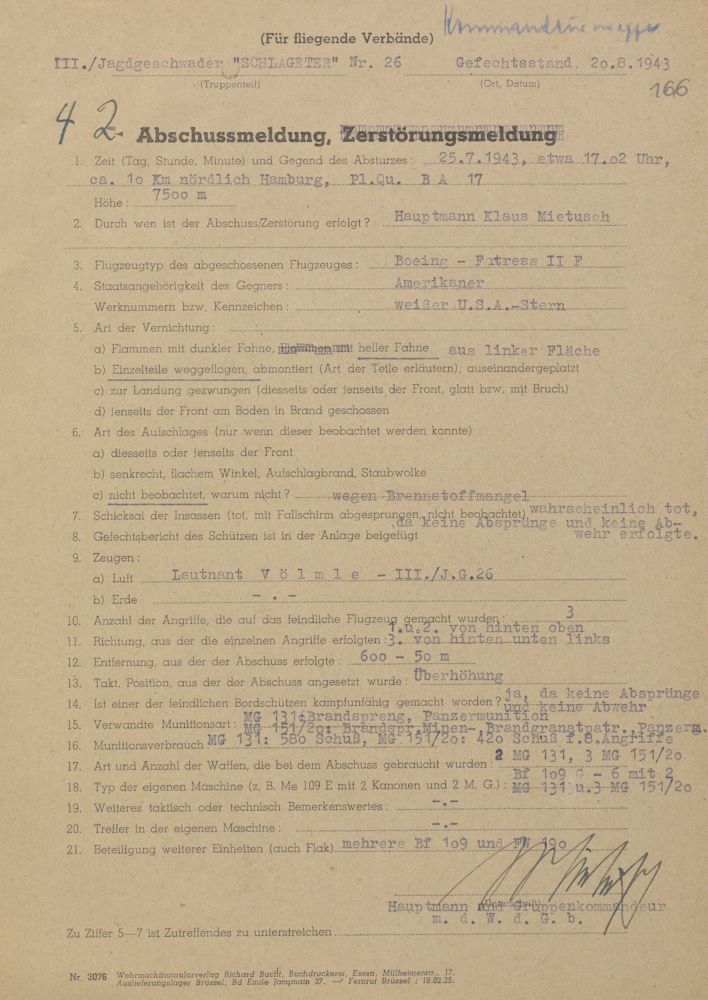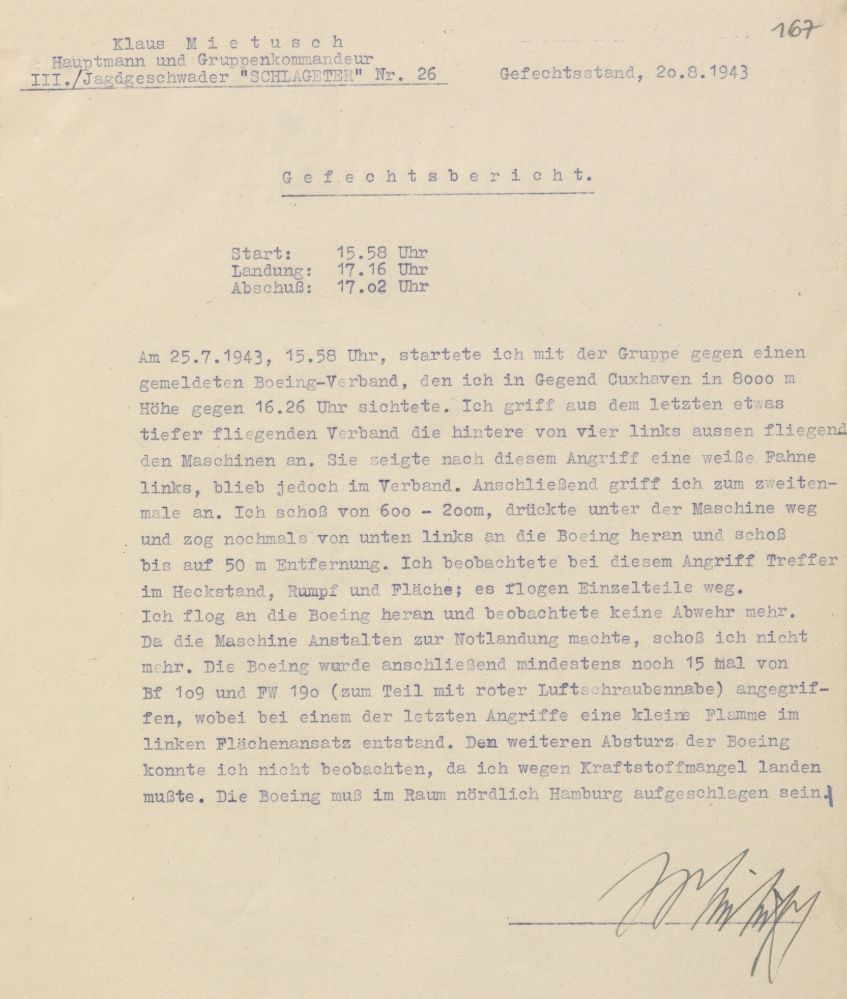
Nordholz airfield, air base with 3 paved runways in a triangle shape.
Code name: "NECKAR"Camouflage number 207Allcode: R 56With heavy beacon "Bohrdommel" and heavy radio beacon "Quelle", on graticule map ground organization large-scale night fighter/air fleet German Reich.
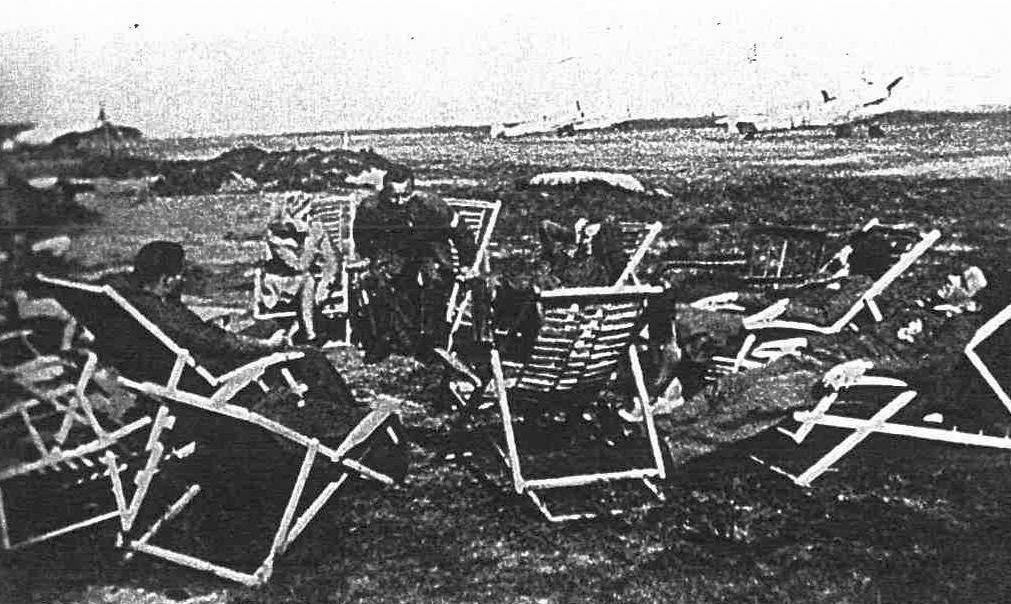
Pilots of the 26th Fighter Wing wait for their deployment in Nordholz.
25.08.1939
II./JG 77 "Herz ASS"As part of the general mobilization for "Fall Weiß" [invasion of Poland in 1939], the squadron with its 40 aircraft, Messerschmitt BF 109 E, was relocated from Pilsen Air Base to Nordholz.
04.09.1939
On 4 September 1939, several British bombers from the 9th Squadron attacked targets in and around Brunsbüttel. The results of the attack were poor, with five Bistrol Blenheims and two Wellingtons lost and only minimal damage done to the German warships at the scene. The heavy cruiser Admiral Scheer was hit by three bombs which failed to explode. The light cruiser Emden, a non-priority target, was damaged by a Blenheim which crashed into the forecastle and exploded. The crash killed 11 sailors and injured 30. The II./Jagdgeschwader 77 under Lieutenant Colonel Carl-August Schumacher took off from Nordholz air base and intercepted the 9th Squadron. Sergeants Hans Troitzsch and Alfred Held each claimed one victory and Lieutenant Metz another. These aircraft from No. 9 Squadron were the first RAF aircraft to be shot down by German fighters during the war. Sergeant Troitzsch was most likely the first German pilot to shoot down a plane.
08.11.1939
II./Tr.Gr.186 (carrier group) With Bf 109 E stationed in Nordholz, subordinated to Stab/JG 1.
27.02.1940
Oblt.Jahny of II./Tr.Gr.186 was able to achieve the first kill for the squadron over the German Bight. It was a Bistrol Blenheim that had been sent by the British Coastal Command to explore the mouth of the Elbe.82.Sqn. Blenheim VI P4842 UX- T/o.12.30 h Watton
F/0. J.C.Blake
Sgt. T.S.Weightman
AC1 S.N.Middleton +
F/O. Blake wurde später angespült und anschließend auf dem Kriegsgräberfeld in Oldenburg begraben. Ihm und seiner Besatzung wird im
Runnymede Memorial in Großbritannien gedacht.
08.04.1940
Kampfgruppe 100 (Bomber Squadron)In preparation for the Norway mission, KGr.100 is moving from Lüneburg to Nordholz. The move begins at 6:30 a.m.
Staff chain 3 Heinkel He 111 H ready for actionGroup commander: Hptm.Artur von Casimir1.Squadron 8 aircraft ready for action, SF: Hptm:Hermann Schmidt2.Squadron 7 aircraft ready for action, SF: Oblt.Gert Korthals
09.04.1940
KGr. 100The individual combat groups of KG 4, KG 26 and K.Gr.100 attacked the Oslo-Kjeller airfield, anti-aircraft positions on the Holmenkollen and coastal batteries on the islands in the Oslo Fjord (including Dröbak and Horten) with bombs. These attacks were carried out by 14 aircraft from K.Gr.100, which had taken off from Nordholz. Four He 111 Hs from 1./K.Gr.100, under their squadron captain Hptm. Schmidt, which were flying in formation over the Oslo Fjord, were shot at by Norwegian anti-aircraft fire. Hptm. Schmidt's aircraft received a 2 to 3 sq.m. large hole in the left wing root. But the aircraft of the commander of K.Gr.100, Hptm.von Casimir, was also hit, so that he had to turn around immediately and land in Nordholz.
10.04.1940
KGr. 100
Um 12:40 Uhr starteten 10 He 111 zum Einsatz. Ziel war die bewaffnete Aufklärung im Seegebiet südostwärts der Shetlands und Orkneyinseln. Die Maschine von Hptm.Schmidt erhielt ca. 40 Treffer von einer Hurricane.
BM. Ofw.Richard Röder + wurde tödlich getroffen.
BS. Uffz.Alfred Traupe wurde verwundet.
12.04.1940
KGr. 100
Das Bombergeschwader KGr.100 verlegt von Nordholz weiter nach Schleswig/SH.
05.05.1940
Two Bristol Blenheims were shot down off the island of Terschelling by a squadron of II./Tr.Gr. 186 from Nordholz.
06.05.1940
Zwei weitere Abschüsse durch die II./Tr.Gr.186 vor der ostfriesischen Küste, je eine Blenheim und eine Wellington.
Not May 1940
Die II./Tr.Gr.186 scheidet aus dem Befehlsbereich des "Jagdgeschwaders Schumacher" (JG. 1) aus und wird zum Einsatz in den Westen geschickt.
Juni 1940
Die II./Tr.Gr.186 wird in Norwegen in Stab III./JG 77 umbenannt.
September 1940
The II./JG 52 moves from The Hague to Nordholz for refreshment.
May 1943
The 4./JG 54 under Oblt. Graf von Matuschka is located in Nordholz.
23.05.1943
Das 8. Bomberkommando der USAAF hatte damit begonnen, Städte entlang der norddeutschen Küste in höherer Frequenz anzugreifen.
An diesem Tag verlegten die III. Gruppe, bestehend aus den Staffeln der 9./JG 26, 4./JG 54 und 12./JG 54, nach Nordholz. Grund hierfür war die Unterstützung des JG 1, III./JG 54 und dem neu gebildeten JG 11, den derzeit wichtigsten Tagesjägereinheiten innerhalb der Grenzen Deutschlands. Kurze Zeit später stieß noch die 7./JG 26 zur III. Gruppe dazu, die aus Russland zurückkehrte.
Einsatzführung für die Maschinen war die JAFÜ - Deutsche Bucht.
Kommandant der 4./JG 54 in Nordholz war Oblt. Graf von Matuschka.
03.06.1943
The pilots spent the day on routine patrols, the only excitement coming when several loose barrage balloons arrived from England.
11.06.1943
The USAAF's 8th Bomber Command attacked port facilities in Wilhelmshaven and Cuxhaven that day. The 252 Boeing B-17s were attacked for over an hour by a number of Luftwaffe fighter units. The first was a new group III./JG 1, which flew from Leeuwarden in North Holland. The III./JG 26 flew its new Messerschmitt Bf 109 G-4/R6 and Bf 109 G-6/R6 from Nordholz against the enemy formations and shot down two B-17s.
Killed: - Uffz.Rudolf Stutt, Staff/III. JG 26,, shot down a B-17 at 17:52 north of Wilhelmshaven.- Fw. Alfred Niese, 9./JG 26, shot down a B-17 at 17:57 in Großheide - Norden.
13.06.1943
III./JG 26 was the first group to attack the aircraft of the 4th Bomber Squadron that morning. The squadron sent 32 Messerschmitt Bf 109 G-6s from Nordholz. At 09:20, the fighter group encountered a formation of Boeing B-17s protected by Thunderbolts and Spitfires over the town of Neumünster. Over the next 25 minutes, until 09:45, the group flew several attacks on the B-17s and claimed 5 aerial victories, all by 9./JG 26.
Kills:- 09:28 hrs, 9./JG 26, Fw. Alfred Niese, Boeing B-17F, 9 km south/southeast of Kiel at an altitude of 8,000 m.- 09:31 hrs, 9./JG 26, Lt. Melchior Kestel, Boeing B-17F, near Schönberg.- 09:32 hrs, 9./JG 26, Uffz. Walter Holl, Boeing B-17F, Königsförde at an altitude of 7,500 m.- 09:36 hrs, 9./JG 26, Uffz. Günther Steinberg, Boeing B-17F, 12 km north/northeast of Selenter See.- 09:38 hrs, 9./JG 26 Ofw. Hans Erbskorn 1. B-17F, 18 km north of Lütjenburg at an altitude of 8,000 m.Losses:- Commander Hptm. Kurt Ruppert , Staff III./JG 26, Bf 109 G-6, W.Nr.16 425. The fighter crashed after being shot at by a B17. When exiting the aircraft, the parachute straps tore and the pilot died in a crash near Wasbeck near Neumünster.
German parachutes had caused the deaths of many pilots, and within the year the old hemp belts were to be replaced by newer materials, a synthetic material similar to nylon. Ruppert was the only JG 26 casualty in this battle.
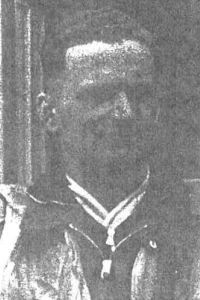
Hptm. Kurt Ruppert Staff III./JG26
15.06.1943
III./JG 26
Hptm. Rolf Hermichen wurde zum Interimskommandeur der 3. Gruppe ernannt und von Poix de Picardie (Fr.) nach Nordholz versetzt.
25.06.1943
The 8th Bomber Command sent 275 Boeing B-17 bombers to attack targets in Hamburg and Bremen. However, the bad weather in the target areas caused considerable difficulties and only 167 bombers were able to drop their bombs over land. While the bombers were approaching the mouth of the Elbe, the fighters of JG 26 attacked the formation. During the fierce air battle between the German and American aircraft over the German Bight, there were losses on both sides. Killed: - Fw. Edgar Dorre 9./JG 26. Boeing B-17 crashed after being shot down at 09.02 hrs 30-40 km northwest of Heligoland. - Ofw. Hans Erbskorn 9./JG 26. Boeing B-17 crashed after being shot down at 09.03 hrs 15-20 km northwest of Wangerooge. Losses: - Uffz. Walter Lohs , 9./JG 26, Bf 109 G-6, W.Nr.15428, "yellow 13" crashed into the North Sea and is missing. - Fw. Alfred Niese , 9./JG 26, Bf 109 G-6, W.Nr.15419, "yellow 3" crashed into the North Sea and is missing.- Leutnant Melchior Kestel , 9./JG 26, Bf 109 G-6, W.Nr.15423, "yellow 4" crashed into the North Sea and is missing.- Leutnant Gerd Kirschlohr , (12./JG 54) III./JG 26 "Schlageter", Bf 109 G6, W.Nr. 15459 (Blue 9). On the return flight to Nordholz, crashed near Blexen. The plane grazed the water surface while flying low and crashed. Lt. Kirschlohr was killed.
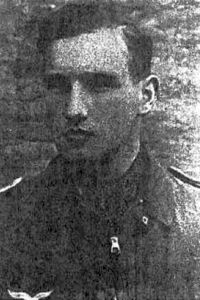
Lt. Melchior Kestel , 9./JG 26
Hptm.Hermann Staiger takes over the 12./JG 26 in Nordholz. In the area of the German Bight he shot down five Boeing B 17s with his aircraft from 17 to 29 July 1943.
Maj. Hermann Staiger, * 06.04.1915 Tennenbronn/Baden RK 16.07.1941 as first lieutenant after 25 aerial victories. Since the beginning of the war with III./JG 51, from Sep. 1940 squadron commander of 7./JG 51. On 14.07.1941 in Russia seriously wounded by ground fire. From 05.07.1943 squadron commander 12./JG 26, on 15.05.1944 commander I./JG 26. From 01.08.1944 commander II./JG 1, in Feb. 1945 to JG 7. One of the most successful four-engine gunners. A total of 63 aerial victories, 13 of them in the East, 26 four-engine aircraft, over 400 enemy missions. Died on June 22, 1964 in Freiburg.
12.07.1943
III./JG 26Uffz. Emil Leitz of the 7th Squadron achieved a confirmed victory over an unknown aircraft type today.
12.07.1943
III./JG 26Another confirmed aerial victory by Uffz. Emil Leitz of the 7th Squadron
25.07.1943
III./JG 26 Approach of the 3rd Group towards the mouth of the Elbe against a bomber formation approaching from the west. In the ensuing air battle, two Boeing B17s were shot down.
Shot down:- Hptm. Klaus Mietusch, CO III./JG 26, Boeing B-17 crashed at 17.02 hrs 10 km north of Hamburg.
- Oblt. Franz Nels, Stab/III./JG 26, Boeing B-17 crashed at 16:32 hrs 10 km southwest of Stade.
28.07.1943
III./JG 26The 3rd Group of Fighter Wing 26 set off northwest at 08:38 to intercept reported incoming bombers. At the limit of their range, the Nordholz fighters engaged in an air battle against American long-range bombers, shooting down three Boeing B-17s. During landing in Nordholz, a pilot from the 7th Squadron destroyed his plane; pilot error was stated as the cause.
Killed: - Ofw. Heinz Kemethmüller, 7./JG 26. Shot down a Boeing B-17 at 09.16 hrs north of Sylt. - Fw. Edgar Dorre, 9./JG 26. Shot down a Boeing B-17 at 09.15 hrs northwest of Heligoland.
- Uffz.Walter Holl, 9./JG 26. Shot down a Boeing B-17 at 09.20 hrs northwest of Heligoland. Loss:- Uffz. Emil Leitz crashed during takeoff and was fatally injured.
29.07.1943
III./JG 26The targets for the heavy American bombers that day were Kiel and Warnemünde. Both cities were located on the Baltic Sea and the flight paths of the Boeing B-17s led far beyond the range of all JG 26 units with the exception of the Third Group in Nordholz.
The 3rd Group reached the bombers at Heligoland and then pursued them across the entire peninsula of Schleswig-Holstein to Kiel. The group shot down two B-17s before returning to base. Three of their Messerschmitts were damaged and Lt. Dieter Volmle, the group's adjutant, was injured.
Abschüsse:
- Ofw. Heinz Kemethmüller, 7./JG 26, Boeing B-17 stürzte nach Bordwaffenbeschuß um 09.30 Uhr 15 km nordöstlich von Schleswig ab (306.BG).
- Oblt.Paul Schauder, CO. 9./JG 26. Shooting down a Boeing B-17 at 09:25 near Schleswig (306.BG).
31. 07.1943
JG 26
Die Dritte Gruppe in Nordholz erlitt bei einem nicht Übungsflug einen schweren Verlust. Der Kapitän der 7. Staffel, Hptm. Günther Kelch, startete spät Abends, um das Abfeuern von 21-cm-Raketen zu üben. Eine davon explodierte als diese abgefeuert wurde, setzte Kelchs Tragfläche in Flammen der kurze Zeit später abbrach. Die Maschine geriet ins trudeln, was es Kelch unmöglich machte aus dem Flugzeug auszusteigen. Anfänglich wurde Sabotage vermutet, die anschließende Untersuchung ergab jedoch nichts.
Bf 109 6-4 W.Nr.19358 „weiße 15“ stürzte um 21.40 Uhr zwischen Neuwerk und Knechtsand ab.
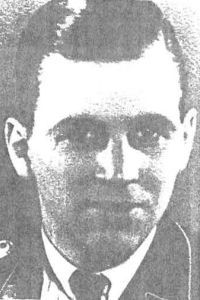
Hptm.Günther Kelch, CO 7./JG 26
13.08.1943
JG 26The Third Group was transferred from Nordholz to Amsterdam - Schiphol today, where it replaced III./JG 54. The "Greenheart Squadron" then made its way to Schwerin on the Baltic Sea to rest there.One pilot from the 7th Squadron, however, did not make the transfer flight. The engine of Uffz. Heinrich Hering's Messerschmitt Bf 109 G4 caught fire shortly after takeoff from Nordholz. Hering was able to eject despite his injuries before the fighter exploded a short time later.Uffz. Heinrich Hering 9./JG 26 Bf 109 G-4, serial number 19213 crashed in Nordholz at 06.38 a.m.
27.11.1943
7./NJG 3
Enemy flight: no
Ju 88 C-6, W.Nr.750342, 05 PH FF Hptm. Anton Baumeister BF Gefr. Harald Ludmann wounded
BS Gefr. Edmund Lenke wounded
22.30 Uhr beim Schulflug durch Überschlag beim Landen.
27.11.1943
7./NJG 3
Enemy flight: no
Ju 88 C-6, W. No. 360134, D5 DV
FF Uffz. Günther Raulfs
BF Uffz. Heinrich Bremer
BS Uffz. Rudolf Herbst
At 21:25 the plane crashed in a curve in Wanhöden near Nordholz due to the landing flaps being extended too early.
16.12.1943
7./NJG 3
Enemy flight: yes
Messerschmitt Bf 110 G-4, Reg.Nr.5458, D5 GR
FF Captain Alfred Heldt Bf Corporal Heinz Reinhold Bw Sergeant Herbert Hübner
That evening, an operation was carried out against RAF bombers flying over Berlin. Shot down by our own anti-aircraft guns, location unknown. Source: Accident Messerschmitt Bf 110 G-4 5458, (aviation-safety.net)
16.- 17.01.1944
Radio documents for the night of 16-17 January 1944: Nordholz 3835 kHz, call sign r5u, code word "Albatros"
March 1944
7./NJG 3 stationed in Nordholz
18/19.03.1944
10./NJG 3
Enemy flight: yes
Bf 110 G-4, W.Nr.180100, D5 EV
FF Fw. Heinrich Herr
BF Uffz. Gerhardt Schmidt
BS Uffz. Heinz Schneider
bei Landung Berührung mit Hochspannungsmast, Aufschlagbrand.
07/08.07.1944
8./NJG 3
Enemy flight: yes
Ju 88 G-1, W.Nr.712204, D5 BS
FF Ofw. Willi Dietrich Fs-jump
BF Ofw. Heinz Hulpke
BS Uffz. Willi Eichner Fs-jump
Crashed NE of Nordholz due to friendly anti-aircraft fire.
11.08.1944
3./NJG enemy flight: noBf 110 G-4, Werk.Nr.440339, D5 LL
Uffz.Günther Schlomberg
Uffz. Otto Wagner wounded in parachute jumpCrash 14 km north of Otterndorf during a workshop flight.
23.08.1944
2./NJG 3
Enemy flight: no
Bf 110 G-4, W.Nr.110042, 05 ??
FF FjFw. Hermann Stähler w.
BF Ogefr. Herbert Preuss
BS Gefr. Günther Pieper w.
During takeoff for a searchlight flight, the plane crashed from a height of about 20 m onto a barracks.
12.10.1944
Aircraft type: P 51 Mustang, single-engine light fighter, USAAF, 44-14074, 364thFG, 384thFS, pilot Lt. Frank T.Kosloski, attack by three American fighters on the air base. One aircraft crashed near Spieka - Knill after being hit by anti-aircraft guns, the pilot made a crash landing and was subsequently taken prisoner of war. Further heavy air battles between German and American air forces in the Elbe - Weser area. Source: W.Oe., T 1022 R 2243-S442
15/16.10.1944
2./NJG 3 Bf 110 G-4, Werk.Nr.160588, D5 LK
Obfw. Gottfried Rensinghoff
Uffz.Erich Kratsch
Uffz.Ludwig HartmannCrash during landing.
15/16.10.1944
Towards the end of the war, the Luftwaffe leadership planned to fly missions with the Me 163 (JG 400) from Nordholz, but this was never carried out. Only II./JG 400 moved from Brandis via Salzwedel and Nordholz to Husum in mid-April 1945, where the unit with a total of 13 Me 163 Bs surrendered to the British troops at the end of the war.
11.1944
I./NJG 3 in Nordholz
05.06.1945
406. Fighter Group 9, USAAF übernimmt den Fliegerhorst Nordholz.
Commander: Lt.Col. Robert C.Brown
mit 512, 513 und 514.Squadron, Motto im Wappen: "ASCENDE ET DEFENDE" (Rise and Defend).
17.06.1945
Nordholz, Army Air Base USAAF
Army Air Base (Airport)
486th Air Service Group (Luft Versorgungsgruppe), bestehend aus: 486. Headquarter squadron, 904th Engineering Squadron, 728th Air Material Squadron. Aufgabe der Einheiten war es, Personal für die Verwaltung,Versorgung und den Unterhalt der Fliegerhorstfahrbereitschaft, die Militärpolizei, das Signalzentrum und für die Krankenstation zur Verfügung zu stellen.
The unit was established on 17 June 1945 in Nordholz by taking over personnel and material from the 74th Air Service Group and served with its tasks and work the 406th Fighter
Group and the subsequent 86th Fighter Group.
June/July 1945
Troop strength: 15 officers, 174 non-commissioned officers and men
The unit's most pressing problem is the ongoing lack of personnel. At the moment, 10 officers and 88 men are missing. In addition, there are another 2 officers and 20 men who are on leave or sick. The situation was also alleviated by using German prisoners of war and civilians.
Aug./Sept. 1945
406. Fighter Group 9, USAAFThe shortage of American forces is becoming increasingly severe. Troop transfers to and from the States are in full swing, where the loss of personnel is much greater than the inflow.
Oct./Nov./Dec. 1945
406. Fighter Group 9, USAAF 16 officers and 257 men are now missing, the morale of those remaining is at a very low level.
03.01.1946
406. Fighter Group 9, USAAF
Republic P-47D Thunderbolt, Wk.Nr.44-33155: Absturz 5 Kilometer vor Nordholz, Totalschaden.
18.01.1946
406. Fighter Group 9, USAAF
Republic P-47D Thunderbolt, Wk.Nr.44-33258: Crashed after collision over the Elbe with a Canadian Spitfire near Brunsbüttel.
04.04.1946
406. Fighter Group 9, USAAF
Republic P-47D Thunderbolt, Wk.No.44-33471: The aircraft crashed during takeoff, total loss.
May 1946
406. Fighter Group 9, USAAF
The improved personnel situation now allows German civilians to be removed from more responsible positions. However, they will continue to be employed as workers.
June/July 1946
406. Fighter Group 9, USAAF
Neuer Kommandeur, Lt. Col John T. Smith. Nach zwei Monaten erscheint die Zeitung "Nordholz on the Sea" wieder.
18.08.1946
406. Fighter Group 9, USAAF, Verlegung nach Manston in England.
20.08.1946
86. Fighter Group 12, USAAF in Nordholz
Commander: Col A.R. McConnell
Stellvertreter CO. Col Earl H. Dunham, (Commander der 406. Fighter Group).
Bestehend aus Headquarter squadron, 525, 526 und 527.Squadron, Motto im Wappen: "VIRTUS PERDURAT" (Courage will Endure). Als Bombergeschwader während des Krieges aufgestellt, ist es später als Sturzkampfbomber- und Jagdfliegergeschwader im Einsatz gewesen. Nach Kriegsende wurde es als Teil der US-Air Forces in Europa belassen, jedoch ohne Personal und Ausrüstung. Im Febr. 1946 in die Staaten verlegt.
Reestablished on 20 August 1946 by taking over the 406th Fighter Group including squadrons 512, 513 and 514 in Nordholz. The 86th Fighter Squadron is responsible for air security of the Bremen enclave and the port of Bremerhaven. Troop strength: 111 officers, 340 enlisted men.
The good weather allowed intensive flight training.
September 1946
86. Fighter Group 12, USAAF in Nordholz The team club outside the air base was closed for most of the month. Only a few dance evenings were held in the service club, as very few female dance partners were available.
During the month, efforts were made to organize German youth groups from the Nordholz area and to encourage them to cooperate with the German Youth Activities department.
Insgesamt mussten noch 1.700 Tonnen deutscher Munition aus den Bunkern entfernt und abtransportiert werden. Die gegebene Zeitvorgabe konnte nur durch 24 Arbeitsstunden pro Tag eingehalten werden. Deutsche Zivilwachen wurden während der Zeit durch amerikanisches Militärpersonal ersetzt.
Flugtraining wurde verstärkt fortgesetzt, obgleich das Wetter sich sehr verschlechterte. Vier Unfälle störten die Tätigkeit des Trainings. Ursache, mechanische Fehler, die auch Verletzungen mit sich brachten. Erhöhte Flugsicherheitsmaßnahmen zur Vermeidung solcher Vorkommnisse. Flugaktivitäten kamen gegen Ende des Monats wegen des übermäßigen Regens zum völligen Stillstand Scherzhaft heißt es jetzt "Nordholz unter der See" statt "an der See".
26.10.1946
86. Fighter Group 12, USAAFRepublic P-47D Thunderbolt, Wk.Nr.44-33184: Belly landing in Nordholz, undercarriage could not be extended, total loss
29.11.1946
86. Fighter Group 12, USAAF, relocated to Lechfeld in Bavaria.
Afterwards, all facilities and runways were blown up and dismantled.* * * * * * * *
Quelle: T.P. , Zusammengestellt von Hans Höhler, Bearbeitet M.B.




